|
||||||||||
|
|
||||||||||
|
||||||||||
|
|
||||||||||

One of the many who contributed to the war effort was Lt. Col. Bill Smith, a decorated pilot who had flown a B-17 Flying Fortress for the US Army Air Force. Now returned from Europe, Smith was put in charge of a routine flight to ferry a B-25D Mitchell bomber from Bedford, Massachusetts, to Newark, New Jersey. The bomber, operating under the call sign Army 0577, was nicknamed "Old John Feather Merchant" and had been converted into a VIP transport. Smith was to pick up his commanding officer at Newark before continuing on to Sioux Falls Army Air Base in South Dakota. The B-25 was a medium twin-engine bomber, far smaller than the B-17 Smith flew over Europe, but both designs saw widespread use throughout the War. Accompanying Smith on his journey was SSgt. Christopher Domitrovich and an aviation machinist's mate from the Navy named Albert Perna. Perna had hitched a ride on the flight to return to Brooklyn and console his parents following the death of their other son who lost his life in the Pacific.
The B-25 departed on its fateful mission just before 9 AM headed south for New Jersey. Less than an hour into the flight, however, Smith received warnings from the New York Municipal Airport in Queens (now called LaGuardia Airport) that thick fog had enveloped the city. The field's control tower ominously reported, "We're unable to see the top of the Empire State. Suggest you land here." Though Smith acknowledged the message, he apparently ignored it and requested clearance to continue to Newark.
The plane was only minutes from LaGuardia but lost in a dense fog that limited visibility. Flight rules of the time required aircraft to maintain an altitude of at least 2,000 ft (610 m) over the city, but Smith dropped to less than half that height hoping to regain sight of the ground. That he surely did, but the pilot had misjudged his location and soon found his plane bounding through the concrete canyons of the city's skyscrapers. The bomber soon attracted attention from alarmed citizens as its roaring engines echoed off the facades of buildings below. Those working in the upper stories of office buildings raced to windows to watch in amazement as a plane flew beneath them, turning and banking rapidly as its wingtips barely missed some structures. One observer was Army Air Force Lt. Frank Covey who spotted the doomed B-25 from his room in the Biltmore Hotel. Covey watched in disbelief as the plane barely missed the New York Central Office Building and was no higher than its 22nd floor.

The bomber raced west roughly following 42nd Street before turning south near the intersection with 5th Avenue. This turn proved a fatal mistake as it brought the lumbering plane directly towards the north face of the world's tallest building. Stan Lomax, a local sports announcer for radio station WOR, was driving to work when he first noticed the sound of propeller engines of the approaching B-25. As he looked up, he yelled, "Climb, you fool, climb!" from his car window.
At the last moment, Lt. Col. Smith must have seen the profile of the Empire State Building looming out of the fog. He tried to pull up while banking away, but the distance was too short and the bomber's velocity too great. At approximately 9:49 AM, the B-25 plunged into the 78th and 79th floors of the skyscraper some 975 ft (295 m) above ground level. The plane impacted at an estimated speed of 200 miles per hour (320 km/h) making the building shake under the force of the collision. The high-speed crash also caused the plane's fuel tanks to explode, sending a fireball 100 ft (30 m) high and releasing blazing gasoline down the facade of the building. Sheets of flame also raced through the maze of hallways and stairwells inside the building, reaching at least as far down as the 75th floor.
The crash tore a hole about 18 ft (5.5 m) wide by 20 ft (6 m) tall in the 34th Street exterior of the Empire State Building. While the 78th and 79th floors bore the brunt of the damage, one of the B-25's engines fell down an elevator shaft and set off a major fire in the basement. The other engine hurtled across the building and tore through seven walls before emerging from the 33rd Street side of the tower. The debris crashed through the roof of a thirteen-story building across the street where another fire erupted. Other heavy wreckage, including the landing gear, also caused damage to the Empire State and nearby buildings while Stan Lomax reportedly saw part of a wing catapulting towards Madison Avenue.
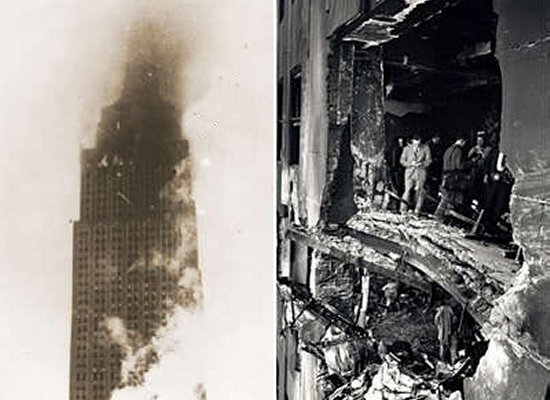
Crowds soon gathered near the base of the wounded skyscraper. According to Walter Daniels of the New York Times, "People sensed disaster. Everyone started running towards Fifth Avenue." The raging fire burned away the fog treating the assembled masses to a clear view of the spectacle above. As flaming fuel and wreckage showered down, however, spectators fled the area to find cover under nearby buildings. Taxi driver Raphael Gomez brought his vehicle to a screeching halt as debris rained down on his cab. "I was so scared, I just sat there. People were running all over," he stated.
After the 1941 attack on Pearl Harbor and long years of world conflict, many naturally thought the city was under attack. This confusion is exemplified by one of the building's workers Doris Pope. "That day, as we were getting ready to take our coffee break, we heard this terrible noise, and the building started to shake. ... As we looked out our third-floor window, we saw debris fall on to the street. We immediately thought New York was being bombed."
Another witness to the disaster was Donald Maloney, a 17-year-old apprentice pharmacist's mate in the US Coast Guard. Maloney had been shopping nearby when he saw the crash and darted into a drug store. "Give me morphine, hypos, needles, first aid kits! It's an emergency," he demanded. Maloney then raced into the Empire State Building to render aid to victims of the crash.
The need for help was greatest on the 79th floor where the offices of the National Catholic Welfare Conference were located. On this Saturday morning, about 20 people were present. Most were young female clerks organizing aid for refugees of the war. Six of the girls never had a chance as they were engulfed in flame and died instantly at their desks, and more workers succumbed to the flames as they tried to escape. Another victim was a female publicist thrown through a window by the blast. Paul Dearing, who was working in the far corner of the Catholic offices, was also killed after he leapt from a window and struck a ledge a few stories down. The rest of the aid workers miraculously reached the safety of a fireproof stairwell required of high-rise buildings.
Catherine O'Connor, who was working near the crash site, further describes the horror of the disaster: "The plane exploded within the building. There were five or six seconds--I was tottering on my feet trying to keep my balance--and three-quarters of the office was instantaneously consumed in this sheet of flame. One man was standing inside the flame. I could see him. It was a co-worker, Joe Fountain. His whole body was on fire. I kept calling to him, 'Come on, Joe; come on, Joe.'" Though Fountain managed to walk out of the fire and escaped the building, his injuries were too severe and he died a few days later. Another victim was a janitor who was trapped by fire and lost his life on the 78th floor. Luckily, this floor was only used for mechanical spaces and storage. Had it been occupied, the death toll could have been considerably higher.
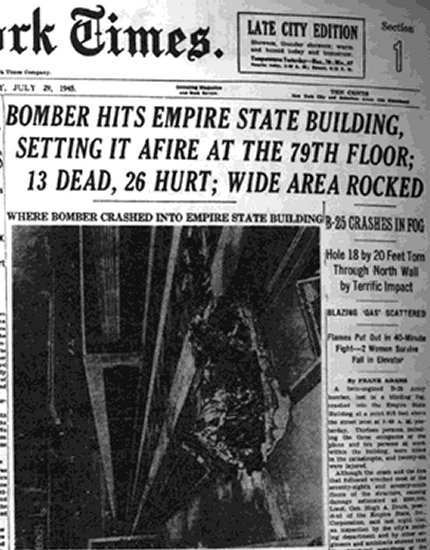
Yet for each tragic death, dozens more defied the odds and escaped the conflagration. A group of 60 men, women, and children were visiting the observation deck on the 86th floor when they were hurled across the building by the B-25 impact. Thick smoke from the intense inferno quickly filled the floor making breathing difficult. Guides were unable to find keys to the glass doors onto the open balcony outside but soon broke them open to let in fresh air. The group was then led down 86 flights of the fireproof stairwell to safety.
As the group passed the 80th floor, they heard pounding on the walls and screams of those trapped inside. This floor held the offices of Daniel Nordan and his assistant Arthur Palmer. Nordan later recalled, "We were lifted three feet out of our chairs and thrown to the floor--I thought it was a Japanese bomb!" The pair tried to flee into a corridor but they were driven back by intense flames from the crash just one floor down. They also discovered a female elevator operator who was badly burned and panicking. The group was only able to escape after the two men used a hammer to break through a wall to another office leading to an undamaged hallway and the fireproof staircase. The pair carried the injured girl through the passage and down the stairs to rescue workers.
The most amazing tale of survival, however, belongs to another elevator operator named Betty Lou Oliver. The 20-year-old woman had just opened the door to her elevator on the 75th floor when the B-25 exploded. The blast threw Oliver out of the elevator and across the hall where two other women from a nearby office found her. Oliver was badly burned, and the two women gave her first aid before helping her into another elevator to reach medical care. Just as the doors closed, the elevator cables snapped sending Oliver and a second female operator plummeting towards the ground.
Coast Guard pharmacist Donald Maloney was waiting for an elevator on the ground floor when he heard the screams of the two girls as their elevator car hurtled past. Maloney and nearby firemen raced downstairs, fearing the worst. Once the firemen used axes to break through a wall, the guardsman crawled into the elevator car and discovered both women battered but still alive. Emergency hydraulics applied brakes to the plunging car, and severed cables hanging beneath the elevator piled up and acted like a coiled spring that slowed the elevator as it fell. Air trapped within the confined space was also compressed by the falling car building up pressure that slowed the elevator's descent. Maloney found Betty Lou Oliver slumped in a corner and covered in debris. Though she was burned and dazed with both legs smashed, her first words upon seeing her rescuer were, "Thank God, the Navy's here! I'll be OK now."
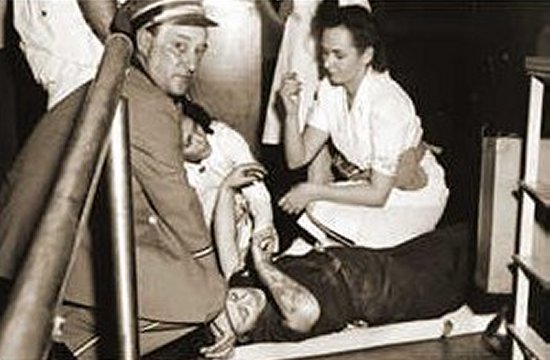
Maloney treated both women and left them in the care of the firemen before racing back upstairs to help more victims. He gave aid to a badly burned man in the lobby as well as several other injured people before joining a priest for the long climb up the skyscraper. Not knowing exactly where the crash occurred, the pair opened the stairwell door every few floors trying to find where the injured might be. As they passed the 70th floor, the men began encountering pools of fuel and oil, scorched walls, and wafting smoke.
By the time they reached the 79th floor, the only people left were those who had already perished in the fiery crash. Despite its initial intensity, the fire largely exhausted itself within 35 minutes and left only charred, smoldering ruins by the time rescuers arrived. The men were soon joined by New York's Mayor La Guardia who, in spite of his rather plump physique, had also climbed all 79 stories. Those present commented on the mayor's flaring temper as he shook his fists and muttered, "I told the Army not to fly over the city!"
Mayor La Guardia later gave Donald Maloney a commendation for the bravery he showed on that tragic morning. Another 17-year-old boy celebrated for his heroism was a Brooklyn student named Herbert Fabian who took over an abandoned elevator and rescued 20 people trapped between the 30th and 40th floors. Harold Smith, who worked on the 62nd floor, was also congratulated for helping firemen rescue three women trapped on a higher level.
The final toll of the disaster was 14 dead and 26 injured. Among those killed were the three crew of the bomber and eleven victims in the building. Nine of the civilian deaths were office workers while the others were a janitor and an elevator operator. The body of the Navy hitchhiker Albert Perna was found two days after the crash at the bottom of an elevator shaft, but the other two crewmen were burned beyond recognition. The crash caused $1 million in damages but workers were reportedly able to repair the building within just three months. Workers had to repair or replace bent girders, seal the walls, and restore the two most heavily damaged floors.
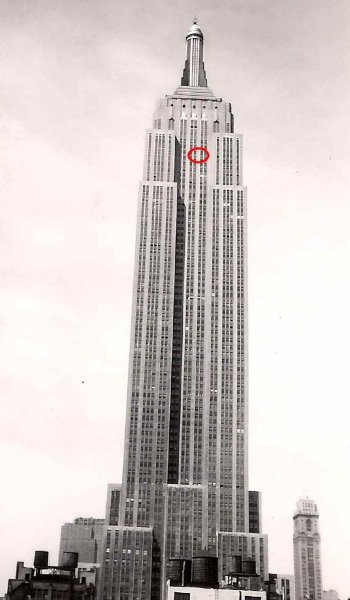
Yet the disaster could have been far worse. The low number of casualties is mostly due to the fact the accident occurred on a Saturday when only a few businesses and relief organizations were open, and roughly 1,500 people were in the building at the time of the crash. On a normal weekday, the Empire State Building housed over 15,000 workers and stood at one of the busiest street corners in the world. The intersection of 34th Street and Fifth Avenue would normally see the passage of over 40,000 vehicles and 200,000 pedestrians in an average day. The death toll might also have been much higher had the B-25 been carrying a bomb load and more fuel since a heavier plane would have done considerably more structural damage. As it was, the bomber was about to land and near its minimum weight.
We will go into greater detail documenting the collapse of the World Trade Center in a future article, but a number of factors explain why the Empire State Building suffered relatively minor damage while the twin towers were catastrophically destroyed. First, the energy of impact sustained by the buildings differed by orders of magnitude. The B-25 that struck the Empire State Building weighed approximately 21,500 lb (9,760 kg) and was traveling around 200 mph (320 km/h). The kinetic energy it created in the collision was about 30 million ft-lb (40 million Joules).
The twin towers of the World Trade Center, by comparison, were struck by Boeing 767 airliners traveling over twice as fast and weighing nearly 15 times as much as a B-25. The energy of impact for the two planes ranged from 2 billion ft-lb (2.6 billion Joules) to 3 billion ft-lb (4.1 billion Joules), some 60 to 100 times greater than that absorbed by the Empire State Building. This estimate is also conservative since it does not account for the energy released by the exploding jet fuel, which greatly exceeded the energy released by the much smaller B-25 fuel supply as well. The greater kinetic energy allowed the 767 aircraft to penetrate much further into the twin towers than the B-25 was able to do at the Empire State Building. Most of the B-25 impact was absorbed by the building's exterior wall leaving very little to damage the interior structure. The 767 impacts, however, not only produced gaping holes in the WTC exterior but also destroyed much of the structural core at the center of each tower.

Even so, the impact alone does not fully explain what doomed the World Trade Center towers. A fatal contributing factor was the fires ignited by the exploding fuel tanks. A 767 has a maximum fuel capacity 35 times greater than that of a B-25D. The aircraft that struck the Empire State Building was nearly out of fuel when it crashed while each 767 still carried approximately half of its maximum fuel load at impact. The Empire State Building fire exhausted its supply of fuel rapidly while that at the World Trade Center ignited the office contents across several floors and burned much longer. The type of fuel carried may also be a significant factor. The B-25 burned avgas, a high-octane version of gasoline still used aboard piston engine aircraft today. The 767 instead uses Jet-A, a derivative of kerosene that fuels all commercial jetliners. Jet fuel tends to reach higher temperatures than gasoline causing the fires in the WTC to burn more intensely than that in the Empire State Building.
Aggravating the situation further was the size of the holes torn in the building exteriors. Fires in office buildings generally consume the oxygen available in the enclosed space rapidly limiting the growth and strength of the fire. The exterior holes, however, allowed fresh air to be pulled into the buildings helping the fires to move through the building and consume additional combustible material. Since the damage to the facades of both WTC towers was far more extensive than at the Empire State Building, more air was available to encourage the fires. The air at the Empire State Building was also damp because of the foggy conditions and may have played a role in limiting the extent of the fires in that structure.
Furthermore, the Empire State Building is a reinforced masonry structure in which the structural steel beams are encased within limestone walls or slabs of concrete 8 inches (20 cm) thick. This heavy mass provides exceptional fire protection that insulates the steel within from excessive heating. Many modern skyscrapers like the WTC towers have eliminated this extensive use of stone and concrete to reduce cost. The World Trade Center instead relied on lightweight spay-on coatings for insulation. This insulation was simply blown off the WTC structure by the 767 collisions exposing the steel beams and floor trusses to the raging fire.
The Empire State Building is also a heavily compartmented structure. Each floor is self contained with its own independent heating and cooling ducts, elevator and utility shafts are surrounded by thick masonry walls, fire partitions separate each floor and rooms within each floor, and the fireproof stairway prevents smoke from rising to upper stories. These features make it very difficult for fire to spread beyond a limited area. The World Trade Center instead offered vast open floor spaces that appealed to tenants but allowed fires to spread far more easily. Moreover, the fire suppression system in both towers lacked redundancy and the 767 collisions cut off the water supply to the sprinklers. For these reasons, the Empire State Building is still considered one of the world's safest skyscrapers in a fire.
The Empire State Building crash of 1945 also offers insights into the Pentagon attack on September 11. Both buildings are reinforced masonry structures built using similar methods and materials, although the Pentagon has been considerably upgraded to survive impact damage. One topic often used to promote conspiracy theories is the size of the hole in the exterior wall of the Pentagon created by the Boeing 757 that struck it. The 757 has a wingspan of almost 125 ft (38 m), yet most conspiracy sites suggest the impact hole is only 15 to 65 ft (4.5 to 20 m) wide. The same can be said of the Empire State Building where a plane with a wingspan greater than 67 ft (20.5 m) created a hole no more than 20 ft (6 m) across.
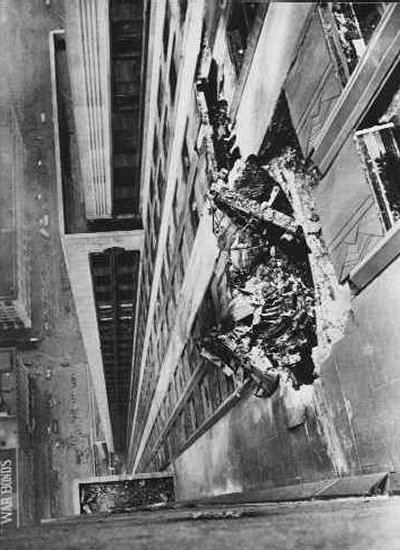
Both aircraft caused damage consistent with the size of the plane and the structural materials used in the facade. Most of the mass of a plane is contained within the fuselage, inner wing structure, and engine nacelles. These portions of the aircraft have the greatest power to penetrate a wall upon impact, and the sizes of the impact holes at both the Empire State Building and the Pentagon are consistent with the dimensions of the fuselage and nacelles of the B-25 and 757, respectively. The outer wings and tail surfaces are much lighter structures consisting mostly of a thin skin enclosing empty space. Upon colliding a thick wall composed of a dense material like stone or concrete, these light aerodynamic structures simply disintegrate. The impact often produces surface gouging and perhaps small, localized holes, but the lighter aircraft structures generally cannot penetrate a reinforced masonry wall. Close examination of both buildings shows gouges extending outward from the central impact hole as would be expected from the collision of wings.
In the aftermath of the 1945 crash, flight rules over New York City were strengthened and the Army Air Force began requiring additional training for pilots transitioning to domestic flying after combat overseas. Tenants also started returning to the Empire State Building as soon as repairs were completed, and the Catholic Relief Services still maintain offices on the 79th floor today. Elevator operator Betty Lou Oliver recovered from her injuries and continues to hold the record for surviving the longest fall in an elevator, over 1,000 feet.
Additional information on the historic event can be found in this contemporary
radio report from the Mutual Broadcast System. The clip even
includes an audio recording of the B-25 flying over a nearby building and the sound of its subsequent crash.
- answer by Jeff Scott, 17 June 2007
Update!
Although the B-25 crash brought new awareness to the danger of low-altitude flight over New York City, a nearly identical accident occurred less than a year later on 20 May 1946. A small twin-engined C-45 transport plane of the US Army Air Force was on a navigation training flight and trying to land at Newark when it became lost in fog. At approximately 8:10 PM, the aircraft crashed into the 58th floor of the north side of 40 Wall Street killing its crew of four.
The accident fortunately happened at night when the building was virtually empty. Only two people were at the site, a bank guard on the 1st floor and a US Navy officer named Charles Atlee working at the Officer's Discharge Center on the 36th floor. Atlee reported, "I was thrown out of my chair and across the office." The fuselage tore a hole 20 ft (6 m) wide by 10 ft (3 m) high in the exterior wall but the engines and wings were torn off and unable to penetrate inside, suggesting the impact speed was low. One engine struck a nearby building and started a small fire while the second fell into Wall Street. The 70-story skyscraper, originally the Bank of Manhattan Trust Building and briefly the tallest building in the world, was repaired and is today also called The Trump Building.
More recently, a 42-story condominium building on the Upper East Side of Manhattan suffered an aircraft collision. Major league baseball pitcher Cory Lidle of the New York Yankees and his flight instructor Tyler Stanger were flying along the East River on 11 October 2006 when the pair crashed into the Belaire Apartments building at a speed of approximately 115 mph (185 km/h). Lidle was owner of the single-engine Cirrus SR20 but it is unknown which pilot was flying the plane at the time of the crash.

The accident occurred as the aircraft was traveling through a narrow flight corridor above the river. As the pilots flew north nearing the end of this corridor, it appears they attempted to make a U-turn back towards the south. Their efforts were complicated by a stiff crosswind, and investigators concluded pilot error caused the plane to strike the 30th floor of the Belaire Apartments. Both Lidle and Tyler were killed in the crash while 21 residents of the apartments were injured. Most injuries were due to fire that engulfed several apartments after the collision. The most seriously injured was Ilana Benhuri who was sitting in the room most of the aircraft debris entered.
The Empire State Building and 40 Wall Street are both reinforced masonry structures while the Belaire Apartments
is a reinforced concrete building. Thanks to the excellent fire protection afforded by this type of construction
as well as the small size and low speed of the aircraft that struck each building, the structural damage suffered
was minor.
- answer by Greg Alexander, 30 September 2007
Related Topics:
Read More Articles:


|
Aircraft | Design | Ask Us | Shop | Search |

|
|
| About Us | Contact Us | Copyright © 1997- | |||
|
|
|||